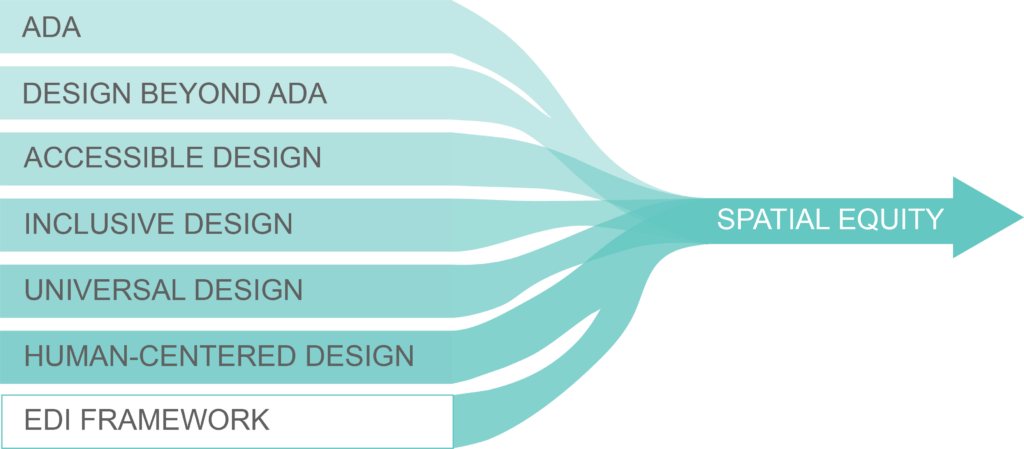At its core the Spatial Equity Research Group is interested in design through the lens of social equity, diversity and inclusion. This post is the final in a series exploring equitable design standards.
Over the past several months, the Spatial Equity Research Group has investigated how equitable design strategies impact the built environment. What we have learned is that each strategy provides an additional lens through which we can design, and the earlier we can apply these strategies, the smoother the equitable design process is. It is important to note that there is no right or wrong solution, but rather any strategy or combination thereof provides a path toward spatial equity.

This is a diagram listing six equitable design strategies in a gradient of teal and “EDI Framework” in white on the left side that blend together with an arrow indicating their progression toward spatial equity. The teal gradient is indicative of degrees of inclusion that each of the equitable design strategies represents.
Building an Inclusive Design Framework
Having a toolkit of equitable design strategies is just one factor in designing for equity. Another way to equip designers is through the use of an inclusive design framework. Whereas equitable design strategies look at how we can improve the tangible built environment to support social equity, an equitable or inclusive design framework looks holistically at the entire design process. This can occur at any stage during the design process, but lends itself better during earlier stages. A key distinction here is that the design framework is established with the user group rather than for the user group. As we continue to evolve our practice and experiment with what works best, one method toward establishing a successful inclusive design framework could be seen as the following:
- Acknowledge Context – What can you learn from your users and their understanding of their space, environment and context? What is important to them?
- Set Goals – Architects can help facilitate equitable goals that users would like to reach.
- Ask Questions – What questions should we ask to understand how issues pertain to the community for whom we are designing? What issues and concerns are important to the community? How can these questions help guide our design process?
- Revisit Goals – What did we learn during the question phase that could help inform and develop tangible goals?
- Integrate Decisions into Design – Design for Equity, Diversity and Inclusion (EDI) with the intended user group in mind.
- Assess Outcomes – Measure the design and results to see if the desired outcome was achieved, if anything could be improved and to provide the users a chance to give feedback.

This is a diagram representing a possible inclusive design framework where each of the six steps in the process is placed inside a teal bubble in a linear sequence so that they follow an order of 1. Acknowledge context 2. Set goals 3. Ask questions 4. Revisit goals 5. Integrate Decisions 6. Assess Outcomes. Steps 2 and 4 have dashed arrows indicating the possibility of revisiting them through a feedback loop.
Moving Forward
The ultimate goal of this effort is to design and build better buildings. Having a more robust toolkit that includes equitable design strategies and an inclusive design framework prepares designers for a dialogue with end users and clients to guide the decision-making process toward spatial equity. When working directly with user groups there is an added layer of trust and sometimes we have to remind ourselves that moving at the speed of trust is a slow process. However, there are numerous benefits to be gained in the end. A strong relationship between architect and client lends itself well to opening the dialogue for designing with equity in mind.
As we continue to research the topic of social equity we look forward to integrating new ways toward including equity as part of both our design process and design outcomes.


